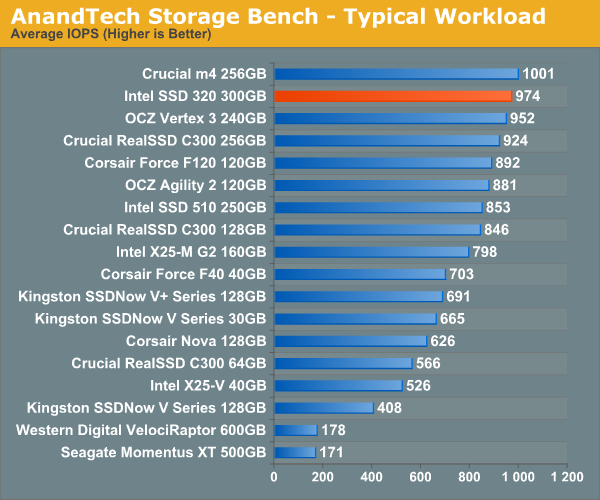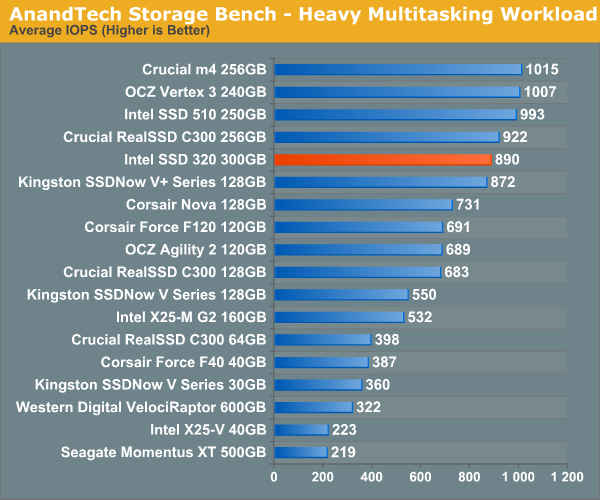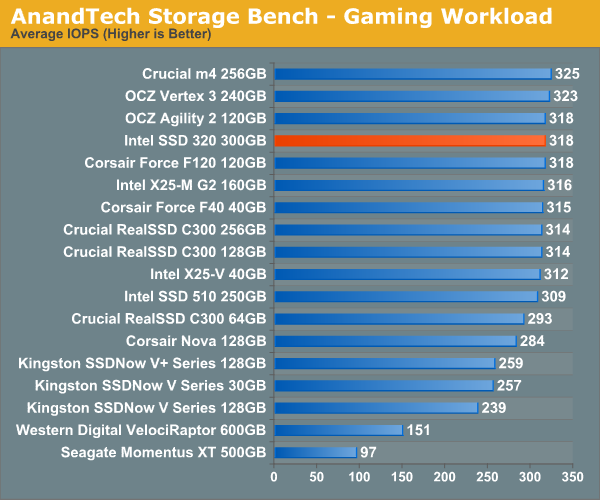The Intel SSD 320 Review: 25nm G3 is Finally Here
by Anand Lal Shimpi on March 28, 2011 11:08 AM EST- Posted in
- IT Computing
- Storage
- SSDs
- Intel
- Intel SSD 320
AnandTech Storage Bench 2010
To keep things consistent we've also included our older Storage Bench. Note that the old storage test system doesn't have a SATA 6Gbps controller, so we only have one result for the 6Gbps drives.
The first in our benchmark suite is a light/typical usage case. The Windows 7 system is loaded with Firefox, Office 2007 and Adobe Reader among other applications. With Firefox we browse web pages like Facebook, AnandTech, Digg and other sites. Outlook is also running and we use it to check emails, create and send a message with a PDF attachment. Adobe Reader is used to view some PDFs. Excel 2007 is used to create a spreadsheet, graphs and save the document. The same goes for Word 2007. We open and step through a presentation in PowerPoint 2007 received as an email attachment before saving it to the desktop. Finally we watch a bit of a Firefly episode in Windows Media Player 11.
There’s some level of multitasking going on here but it’s not unreasonable by any means. Generally the application tasks proceed linearly, with the exception of things like web browsing which may happen in between one of the other tasks.
The recording is played back on all of our drives here today. Remember that we’re isolating disk performance, all we’re doing is playing back every single disk access that happened in that ~5 minute period of usage. The light workload is composed of 37,501 reads and 20,268 writes. Over 30% of the IOs are 4KB, 11% are 16KB, 22% are 32KB and approximately 13% are 64KB in size. Less than 30% of the operations are absolutely sequential in nature. Average queue depth is 6.09 IOs.
The performance results are reported in average I/O Operations per Second (IOPS):

If we strip 6Gbps out of the equation completely, the SSD 320 does very well in our old light workload. You're looking at performance that's at the top of the pack from the mainstream offering.
If there’s a light usage case there’s bound to be a heavy one. In this test we have Microsoft Security Essentials running in the background with real time virus scanning enabled. We also perform a quick scan in the middle of the test. Firefox, Outlook, Excel, Word and Powerpoint are all used the same as they were in the light test. We add Photoshop CS4 to the mix, opening a bunch of 12MP images, editing them, then saving them as highly compressed JPGs for web publishing. Windows 7’s picture viewer is used to view a bunch of pictures on the hard drive. We use 7-zip to create and extract .7z archives. Downloading is also prominently featured in our heavy test; we download large files from the Internet during portions of the benchmark, as well as use uTorrent to grab a couple of torrents. Some of the applications in use are installed during the benchmark, Windows updates are also installed. Towards the end of the test we launch World of Warcraft, play for a few minutes, then delete the folder. This test also takes into account all of the disk accesses that happen while the OS is booting.
The benchmark is 22 minutes long and it consists of 128,895 read operations and 72,411 write operations. Roughly 44% of all IOs were sequential. Approximately 30% of all accesses were 4KB in size, 12% were 16KB in size, 14% were 32KB and 20% were 64KB. Average queue depth was 3.59.

Crank up the workload and the 320 falls a bit behind the rest of the competitors. Last year's heavy multitasking workload is nothing compared to what we introduced earlier this year, so it's still pretty light by comparison but it's clear for normal usage the 320's 3Gbps performance is quite good.
The gaming workload is made up of 75,206 read operations and only 4,592 write operations. Only 20% of the accesses are 4KB in size, nearly 40% are 64KB and 20% are 32KB. A whopping 69% of the IOs are sequential, meaning this is predominantly a sequential read benchmark. The average queue depth is 7.76 IOs.











194 Comments
View All Comments
piquadrat - Monday, March 28, 2011 - link
Theoretically for working encryption you need bios with ATA password support. If you're out of luck there is also a way to mod existing bios and add appropriate extension, but skills and experience required.The thing is:
There is no evidence that BIOS password in intel's implementation is LINKED to AES password generated by internal cypher engine!!!
If not, this solution is no different than SF-1200 non-enterprice drives. You can enable ATA pass on OCZ Vertex2 but it is not used to hash internal encryption keys which effectively renders the whole AES thing USELESS (security wise).
wvh - Tuesday, March 29, 2011 - link
Thanks... But I'm even more confused now. ;)piquadrat - Tuesday, March 29, 2011 - link
Lets wait until some further details concerning intel's implementation make to the public. I'm sure that early adopters will test this feature thoroughly. Now all of this is mainly academic.danjw - Monday, March 28, 2011 - link
Have you forgotten the P67 fiasco already?neotiger - Monday, March 28, 2011 - link
So after all these delays Intel released a product that can just barely keep up with the LAST generation of competing products. Meanwhile, competitors are releasing new gen of products at significant performance increases.In other words, Intel just GAVE UP on the top end of the market and is now just trying to be the cheapest product.
Truly disappointing.
FXi - Monday, March 28, 2011 - link
$1069 for a product only guaranteed to work 3 (THREE) years. IF it fails after that time, you've paid over $350 a year for storage. The 300 works out to $190, almost $200 PER YEAR for storage.If Intel feels so confident that these things will last, do the same as the rest of the enterprise grade industry and give it 5 years of "we're positive it will work this long".
Watch the rest of the SSD market cry if Intel does this, but they won't. These things are bad enough if something goes wrong at year 2 or 3, but past that it's the wild west. And given the prices, that shouldn't be the case.
$1069 is a decent price. $999 would have been excellent, but either price is horrible when compared to only a 3 year guaranteed lifespan.
iwod - Monday, March 28, 2011 - link
Personally i think it is too expensive. But,1. It would still sell very well. Because 90% of users are still with SATA 3Gbps. And Intel Drives are the most reliable SSD out there, currently its pricing is not cheap, but competitive.
2. Intel aren't keeping up with production volume anyway for their 25nm SSD. ( Note most of the Intel 25nm NAND sold to other company are proberly Tier -2 Bin NAND )
Yeah, we are disappointed, but it is still going to do well.
Let's Hope Future Intel SSD will beat even the Sandforce 2200 Series.
Lingyis - Monday, March 28, 2011 - link
Reliability is a big issue! I'm not a super-techie, but as a user, having experienced 2 out of 3 Vertex drives that I ended up having to reinstall the OS (once Windows 7, once Mac on my wife's machine) within 6 months, I have reverted to using good'ol hard drives for myself.Intel's higher reliability might be good enough--but hard drives are still more reliable. (if anybody has hard statistics to back me up i'd highly appreciate it)
sean.crees - Tuesday, March 29, 2011 - link
I've personally had MUCH more issues with HDD's than SSD's. Though that likely has to do with the fact that the only SSD's I've worked with are my 2x 1st gen 80g Intel SSD's, and I've spent the last 15 years dealing with HDD's.My biggest issue with HDD's is exposure to heat. I've lost my A/C in the summer, and then subsequently lost all my data on my HDD's because it got too hot for them. You don't have this problem with SSD's.
Also, any tech device is going to have DOA's. Just because you got a bad batch, doesn't mean the entire industry as a whole is worse than older tech. And, OCZ has come a LONG way since their initial reliability issues with their 1st gen Vertex drives. They have listened to their customers, and listened to reviewers like Anand, and have implemented changes to make their products meet our expectations. This one simple act above all else is what pulls me away from the Intel camp to purchase a Vertex 3 for my next SSD.
jwilliams4200 - Tuesday, March 29, 2011 - link
Are you insane? OCZ is meeting expectations?How could you have missed that just in the last few months, OCZ has changed their products to be lower performing and less capacity than previously, without informing customers or even changing the product SKU? Or that OCZ uses Spectek flash instead of higher-tier Micron flash memory in some of their SSDs, but a customer cannot know which flash they got without opening the SSD and voiding their warranty?
OCZ are nothing but con men and spin doctors. If you think OCZ cares about their customers and treats them with honesty and respect, then you are awfully naive.
Besides, the statistics show that Intel is the most reliable SSD. Even without the statistics, it is easy to see why Intel is more reliable. Intel uses the highest quality parts, including getting the highest bin flash memory from their manufacturing lines, and Intel testing and quality control is a corporation wide thing. I doubt OCZ even knows the meaning of the words.